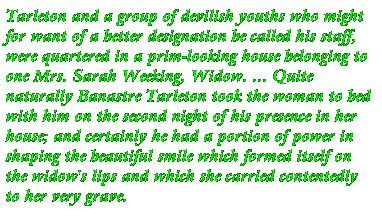


| [ Previous ] [ Next ] |

|
[published by M. Evans and Company, Inc.; New York; 1975.]
After sampling the first three or four pages, I concluded this book was unreadable, so it's another one where I'm just going to make a few isolated comments. Unlike Byrd's Jefferson, though, I have fairly good things to say about Valley Forge. It's a purely stylistic thing which was the show-stopper for me, and for anyone who can swallow that, I think the book would make good entertainment. I skimmed through, looking for Ban and anyone else of interest, and read a few scenes (in one case a whole chapter) at random. They were quite good.
The show-stopper is the fact that the majority of the book is written in the first person from the perspective a generic Continental soldier at Valley Forge -- or possibly more than one, I couldn't tell on a quick flip if it was always the same guy. It's pure stream-of-consciousness, and written in a thick, "uneducated hick of the 18thC" dialect. Think Finnegan's Wake in a coonskin cap. Well, okay, it's not really that bad, but it was far more than I was willing to wade through in search of the story. Ten pages of it would've driven me mad, far less three hundred, but some people enjoy that sort of thing so it's a matter of personal taste.
Mixed in with this Fess-Parker-ish "reminiscin'" are chapters told in third person, in perfectly normal language, some of them little captured moments from the point of view of Wayne, Washington and others. Sampling at random, I hit several which were nice. One of Washington, lying in bed beside Martha, staring at the ceiling and pondering life -- including whether or not he'd live to be as unbelievably old as Ben Franklin -- hit me as especially charming for some inexplicable reason. When he isn't being an Artiste, Kantor seems to have a fine handle on character portrayal.

|
Kantor's Banastre Tarleton is pure killing machine but he certainly avoids my complaint about dull two-dimensionality. He's in only about four scenes -- and one whole chapter -- but manages to become quite a vivid person in that short space. Kantor has built himself an original character derived from the "Butcher" legends -- shifted back in time to the Philadelphia campaign -- blended with large dollops of his own imagination. It's pure fiction, but on that level it works pretty well.
His Ban runs around the country at the head of a proto-Legion -- it must be a company of the 16th Light Dragoons given the time period, but what the heck Sir William Harcourt thinks of all this is anyone's guess -- who are thoroughly wild and bad. I kept getting mental images of a cavalry troop in red leather regimentals and queued Mohawks, with their musicians riding hell-bent-for-leather after them playing "Bad to the Bone" on their bugles and drums. Okay, again not that bad, just outrageous -- and fun in its own peculiar way. At least Kantor has given Ban the wealth of swashbuckling panache which so many writers ignore.
Plus, there are some (intentional) laughs in the chapter which introduces him. It's a flashback to his youth, starting with his first unfortunate encounter -- aged about three, one would guess by how he's written -- with a horse. Or, rather, with a fat and mean-tempered Thelwellian pony who terminates his nascent and parentally unauthorized ambitions to become a cavalryman by pitching him headfirst into a bog.
It's a book worth giving a try. You'll know within a chapter whether or not you can read it. If the artsie style works for you, you'll probably enjoy the rest.
| [ Index ] | [ Previous ] [ Next ] |
| Return to the Main Page | Last updated by the Webmaster on January 30, 2004 |